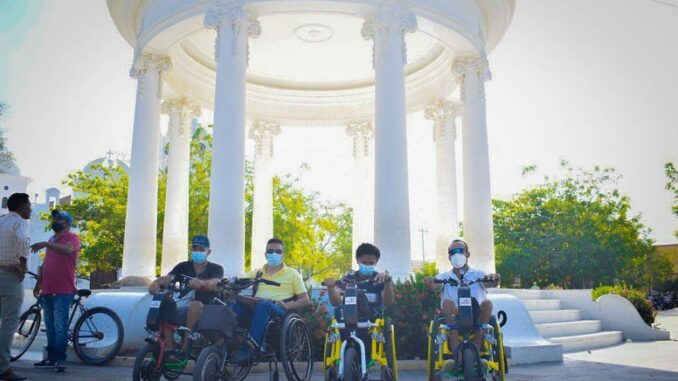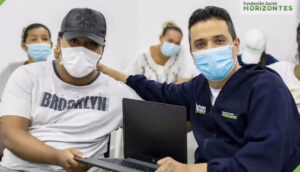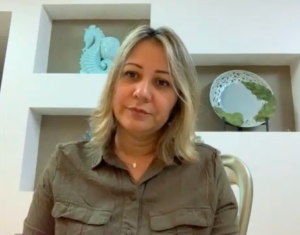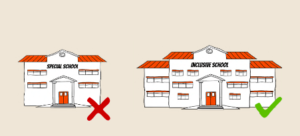
Dilan Torres lost the mobility of his legs four years ago due to a medical condition. Today, he is a university student who survived depression to tell the story.
Ludwing Dávila is also a wheelchair user. Today, he works in a foundation helping other disabled.
Juana Perez’s daughter has cerebral palsy. She has dedicated more than 25 years to help disabled be part of society and is now part of her city’s Disability Committee.

All these people living in Ciénaga, Colombia, have had their lives turned around by the Horizontes Social Foundation.
The municipality of Ciénaga, located in Magdalena, Colombia, is known as one of the cities in the country that is most committed to helping disabled become part of community, which they do through the “Community-Based Rehabilitation” strategy (CBR), led by the non-profit organization “Horizontes Social Foundation” in agreement with the Ciénaga Municipal Mayor’s Office. The CBR strategy was initiated by the WHO in 1978, aiming to enhance the quality of life for people with disabilities and their families; just like Dilan. Meet their basic needs, and ensure their inclusion and participation. It has allies mostly from low-income and middle-income countries, such as Colombia.
Ingrid Bermúdez, coordinator of the education department in Horizontes Social Foundation, says that in countries like Colombia, disability, ignorance, and poverty are directly related. This might be why there is more violation of rights compared to other countries. And the paradigm is that people with disabilities ‘have a disability’ and because of that they have nothing more to give to the world… Many times, this is why they end up completely dependent on their family, homeless, or with informal jobs, working on the streets begging for money or food, which is very common in Latin America. “And this is what we want to change, because for a disabled person everything is an achievement, even being able to do the activities of daily life. When we as a foundation manage to get a person to be able to rehabilitate themselves in the minimum activity of their daily life, for us it is a great success. And for them it is a double success.”

Dilan thinks that his life would be completely different if he hadn’t accepted his friend Ludwig’s invitation to attend one of the meetings at the foundation. He never stopped attending since then. “If I hadn’t reacted in time, maybe I wouldn’t be telling you the story today.”
Many times, families are not interested in entering the program, either due to ignorance or fear. This is why they try to reach as many people as possible, because although they have the government support, where they can get all the information and the census data, sometimes it’s hard to reach communities living in rural areas. They use many options to get the word out. This includes announcements in the local radio and local news channel; publicity on social media such as Instagram and Facebook; word of mouth; and periphonum. This last one is popular in Colombia in small cities, which is broadcasting through loudspeakers (most of the times the speakers are on top of a car that moves around the city) a message of any kind.
According to the World Health Organization (WHO), about 15% of the world population lives with a disability. The number is estimated to exceed 1,000 millions of people. And as of 2021, around 85 million people with disabilities live in Latin America and the Caribbean, which represents 14.7% of the regional population. Which is basically equal to the combined population of Colombia and Peru.

Exclusion has been proven to have an impact from childhood, causing people with disabilities to be less likely to complete formal education and 15% of the children not to attend school, thinking children with disabilities can only attend a “special school” for them, when all they need is an inclusive one. And then, one out of two people not to participate in the labor market. Poverty, lack of access to education and job opportunities, informality, lack of recognition of legal capacity, and discrimination, are realities that people with disabilities live with every day.
Today, you can see famous artists, such as Stephen Hawking and Andrea Bocelli, successful people who have accomplished great achievements, who are disabled. Painters, scientists, singers, who have autism, down syndrome, or who are physically impaired, showing the world that they have a lot to contribute to society and being a role model for those who are just beginning the process.
Colombia has made decisive progress in guaranteeing the right to inclusion of people with disabilities, but much remains to be done. “We believe that we are doing a very important labour that is making history in our country, and that it is being replicated in other cities. Ciénaga being such a small city, we are an example for the rest of the country, and that makes us feel proud and motivates us to continue doing what we do.”
This video has both English and Spanish subtitles so both audiences can enjoy the content of the report.

Be the first to comment